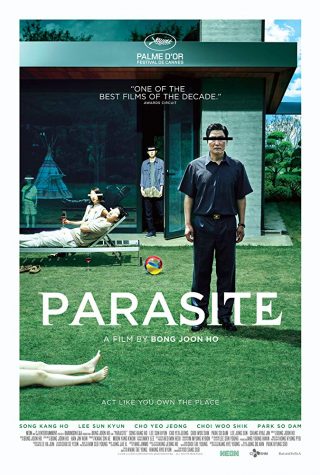Parasite’s Representation of Class Struggle is Unparalleled
In 2019, many movies came out detailing the idea of class struggle in some form. A common theme in the film industry, some movies which highlighted class struggle were Parasite, Little Women, and Joker. These films, specifically Parasite, as a part of an industry which often portrays prominent issues of the time when they were made, shed light on an issue affecting many people around the world.

With Parasite, winner of the 2019 Palme d’Or at the Cannes Film Festival, South Korean director Bong Joon-ho stunned audiences around the globe with his intensely violent yet hilariously funny film. Bong has a history of discussing class relations in movies like Snowpiercer and The Host, and Parasite is no different. In Parasite, the poor Kim family integrates itself into the rich Park one, and throughout the film, the Kims discover a dark secret within the Park household. Conscious of economic disparity, Parasite utilizes many different cinematic features to portray class interaction. Specifically, Bong perfectly uses setting and tone to display the disparity between rich and poor, along with metaphors common throughout the entirety of the film. Regarding setting and tone, clear visual differences are used to emphasize the difference between the filthy slums and seemingly flawless wealthy neighborhoods of Seoul, but as the film continues, specifically at the end, the two settings seem parallel to each other. The movie, over time, portrays the slums as dirty and destitute and the rich neighborhoods as pristine, but Bong slowly draws the two closer, almost pointing out the ugly underbelly of high society as the movie reaches its climax, a bloody free-for-all at a beautiful party, ending in the deaths of several characters.
In Parasite, Bong points out the difference between the rich and the poor by using the strong, yet blatant metaphor that the poor characters are not only socioeconomically “under” the rich, they’re physically under them too. Through the use of creative camera work, the poor characters are nearly always framed below the rich ones, and as if to express the growing gap between the two classes, Bong utilizes a long sequence of shots to show the Kims returning to their home as they run down hundreds of steps to their “semi-basement” home. Going along with that, the soundtrack to that set of scenes is constantly descending, and uses the theremin to give off an eerie sound, strengthening the offputting feeling common throughout much of the movie.
Just before the long sequence of shots of the Kims descending towards home, we’re shown Park Da-song, the son of the Park family, playing in the rain. His gleeful ignorance is apparent, yet doesn’t seem to mean much to the story as a whole until just a few shots later. As the Kims descend to their home, it becomes increasingly apparent that their neighborhood has been flooded by the same water in which Da-song was playing, a metaphor for things which the wealthy profit off of that the poor suffer because of, like climate change inactivity and low taxes on the rich.
After the Kims arrive at home, we’re shown a few different scenes which perfectly display the feeling of being defeated. First off, we see Kim Ki-jeong, daughter of the Kim family, smoking cigarettes in the bathroom, as her house continues filling with water. Not only does this provide a powerful view of helplessness, it shows how people tend to cope under high stress situations, adding to the gritty, realistic tone of Parasite’s Seoul slum. After this scene, the Kims are shown leaving the slum, and spending the night at a shelter, in which Kim Ki-taek, father of the Kim family, discusses how he’s decided to stop planning for the future, as all of his past plans have failed. This hopeless feeling is common when social mobility is near impossible, as portrayed in Parasite.
As the movie nears its ending, we see Kim Ki-woo, son of the Kim family, dream of becoming rich. In this dream, he’s bought the Park family’s house, and has moved on from his life in the slums of Seoul, and just as the dream sequence begins to feel real, viewers are drawn back to a view of Ki-woo in his semi-basement home, a symbol of the poor conditions lower class people live in, and struggle to get out of.
Overall, Bong Joon-ho’s Parasite perfectly portrays the struggle between rich and poor, along with the feelings often associated with lower class life. Full of metaphor, with a great soundtrack, and even better directing, Parasite shows that Bong Joon-ho is at the top of his game, and is likely to get better, all while raising awareness for class struggle.

My name’s Luke, I’m editor of the Lance this year, and I’m super excited to be a part of such a great program! I'm a senior at Hellgate, and this...




